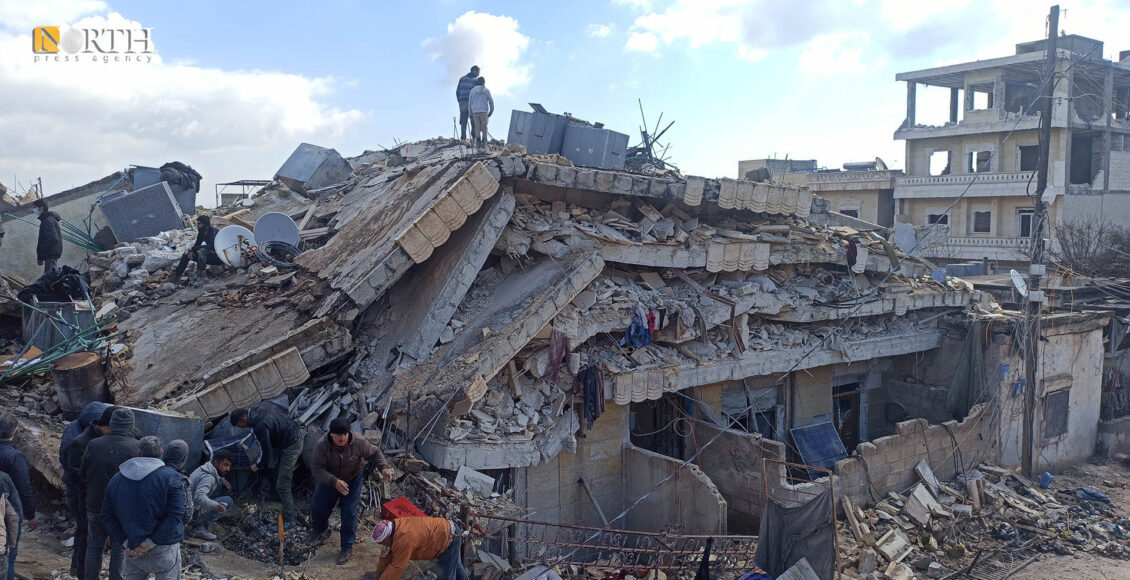Human losses, material damage caused by earthquake
QAMISHLI, Syria (North Press) – Nearly all of northern Syria has been affected by the earthquake that hit the country on February 6 with a magnitude of 7.8. Tremors continued up to February 8. A state of emergency has been imposed on the entire country by all ruling parties. Children, pregnant women, people with special needs and prisoners are among the worst-affected. Northern Syria’s infrastructure has been widely damaged.
Figures
According to North Press Monitoring and Documentation Department, the death toll in Syria has reached 3.199, and injuries stand at 4.969. 55 per cent of both figures are children.
In areas under the control of the Syrian government, 1.739 deaths and 2.255 injuries were reported in recent updates. While in areas under the control of opposition factions in northwest Syria, 1.454 deaths and 2.749 injuries were recorded. Six deaths and 65 injuries were recorded in areas of the Autonomous Administration of North and East Syria (AANES).
Thousands of people remain trapped under the rubble in central and northwest Syria. Tens of thousands remain outdoors.
Nearly 900 buildings have reportedly collapsed, 1.500 others are partially damaged.
General outlook
Syrian government areas
The earthquake has left 3.994 victims in the areas under the government’s control. Figures given by the Syrian government are not final as search operations for survivors continue in Aleppo, Latakia, Tartus, Hama and the countryside of Idlib.
The number of collapsed buildings stands at 400. Many are at-risk after twelve years of war.
A number of damaged buildings have been evacuated, fearing further tremors or another earthquake. Residents have been relocated to accommodation centers, public parks, and onto streets amid freezing winter temperatures.
Authorities have declared a state of emergency in hospitals and medical centers, including private ones, in all areas under their control. Mosques, churches and schools remain open to receive people affected by the earthquake.
The Syrian government received aid from a number of Arab countries, including Lebanon, Algeria, Iraq, Bahrain, UAE, as well as the Russian Federation and Iran. Local initiatives have been in operation, too.

Rescue and search for survivors operations continue in the government-held Aleppo Governorate
Opposition-held areas
Ruling authorities in northwest Syria have declared their areas of control as disaster areas. 4.203 people have fallen victim to the earthquake. Nearly 7.000 people remain without shelter, owing to the damage to their houses. The town of Jindires, west of Afrin of northwest Aleppo, as well as Sarmada, Salqin, Armanaz, and Atmeh in Idlib, are the worst-affected by the quake. Searches for survivors continue in these areas. No precise figures are available on deaths and injuries. Hundreds of families are thought to still lie under the rubble. Authorities and locals work hand-in-hand to retrieve survivors.
There are more than 400 collapsed buildings and 600 partially or seriously damaged ones. No aid has yet reached the area despite announcements to the contrary. Nothing has been delivered through the Bab al-Hawa crossing except for the 100 bodies of Syrian who died in the earthquake in Turkey.
Children in these areas are most affected and they are in dire need of psychological support.
Collapsed residential buildings in opposition-held Idlib Governorate, northwest Syria
AANES areas
AANEA areas have been affected by the earthquake. Hundreds of buildings have been damaged. Thousands of buildings could collapse at any moment in the case of aftershocks or earthquakes.
A building in Raqqa and another in Kobani collapsed. A large number of houses and buildings have been either partially or seriously damaged. Archeological sites, including the Raqqa Wall, Castle Necmettin and Maiden’s Castle in Raqqa, were also affected.
In the last two days, locals have been living outdoors – either in their cars or in accommodation centers established by the AANES. Many people have headed to the countryside.
The AANES declared a state of emergency in all its areas and prepared special rescue and emergency teams. It has sent a batch of aid to the Sheikh Maqsoud and Ashrafiyeh neighborhoods in Aleppo city. Shahba region continues to be under siege by the Syrian government. It has placed an embargo on the region for the past six months. No aid has reached Shahba yet, though it, too, was affected by the quake.

Collapsed residential buildings in opposition-held Idlib Governorate, northwest Syria
Humanitarian situation
Thousands of Syrians are in need of international relief and medical aid, as well as rescue teams. There are no routes through which to deliver aid except for the airports of the Syrian government forces.
The UN Security Council and all agencies should look for other channels to deliver aid to Syria. The decision to close border crossings to aid outside of areas under the control of the Syrian government forces should be reconsidered.
All concerned parties should device new mechanisms to provide psychological support to survivors, notably children.

